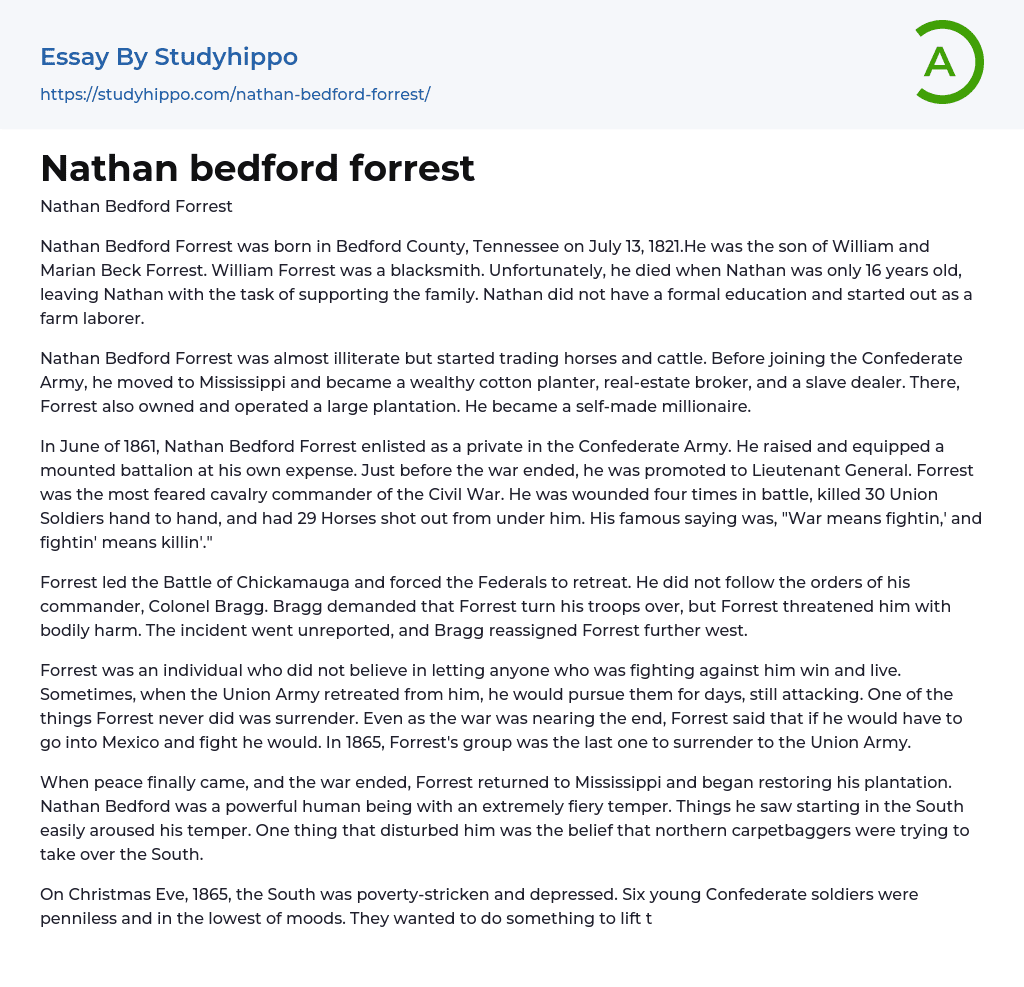Nathan Bedford Forrest, born on July 13, 1821 in Bedford County, Tennessee, was the son of blacksmith William Forrest and Marian Beck Forrest. Tragically, when Nathan was just 16 years old, his father passed away, leaving him with the responsibility of providing for his family. Despite his lack of formal education, Nathan initially worked as a farm laborer but eventually found success in trading horses and cattle. He later relocated to Mississippi where he achieved great financial prosperity as a cotton planter, real estate broker, and slave dealer on a large plantation.
In June of 1861, Nathan enlisted in the Confederate Army as a private and personally raised and equipped a mounted battalion. Throughout the course of the war, he steadily climbed through the ranks to become Lieutenant General shortly before it came to an end. Known for his reputation as one of the mos
...t feared cavalry commanders during the Civil War, Forrest endured four battle wounds during his service. He engaged in close combat where he single-handedly killed around 30 Union Soldiers and had 29 horses shot from underneath him. One notable achievement was leading the Battle of Chickamauga which resulted in Federal forces retreating.During the battle, despite receiving orders from Colonel Bragg to surrender his troops, Forrest refused and even threatened Bragg when confronted. Known as an influential figure during this time, Forrest expressed his views on warfare with the famous quote: "War means fightin,' and fightin' means killin'." After an unreported incident, Bragg reassigned Forrest further west. Despite setbacks, Forrest remained determined and relentlessly pursued the retreating Union Army. Towards the end of the war, he even showed willingness to fight in Mexico
In 1865, his group was the last to surrender. Post-war, Forrest returned to Mississippi with a goal of restoring his plantation.
Another powerful individual with a fiery temper was Nathan Bedford who grew angry at events in the South. Particularly disturbed by northern carpetbaggers taking control, he formed a club called Klan on Christmas Eve of 1865 along with six penniless Confederate soldiers. The purpose was to bring joy and amusement through masquerade costumes made from items found in their linen closets due to financial limitations. They dressed themselves up with sheets and pillowcases on their heads and bodies while also outfitting their horses similarly.Riding around at night and performing foolish acts, the Klan inadvertently caused fear among newly freed Black community members who mistakenly believed they were supernatural beings. This created apprehension among these individuals about their newfound freedom. Initially seen as a joke by the Black community, the Klan's actions became increasingly violent as more members joined. One of their main goals was to prevent ex-slaves from voting in elections. In May 1866, Forrest learned about the influential Ku Klux Klan movement originating in Pulaski, Tennessee. Intrigued, he went to Nashville seeking advice from Captain John Morton, his former Chief of Artillery during the war. During this meeting with Capt. John Morton, Nathan Bedford Forrest officially joined the Klan. Afterwards, a gathering was held to choose a more impactful name for the group: "Ku Klux Klan, the Invisible Empire." After much discussion, Forrest was appointed as the first and most powerful Grand Wizard of the Ku Klux Klan. He amassed a significant following of 100,000 Klansmen throughout the former Confederacy and led them for
several years as both membership and violence escalated. Concerned by these developments, Forrest eventually distanced himself from the Ku Klux Klan and focused on accumulating wealth at his residence where he later became President of Marion Railroad Company.
On October 29th, 1877, he died from diabetes.
- Culture essays
- Social Control essays
- Citizenship essays
- Social Justice essays
- Caste System essays
- Social Responsibility essays
- Socialization essays
- Deviance essays
- Modern Society essays
- Popularity essays
- Civil Society essays
- Community essays
- Female essays
- Filipino People essays
- Igbo People essays
- Indigenous Australians essays
- Indigenous Peoples essays
- Minority Group essays
- Social Institution essays
- Men essays
- The nation essays
- Middle Class essays
- Social Norms essays
- Discourse Community essays
- Popular Culture essays
- Car Culture essays
- American Culture essays
- Mormon essays
- Indian Culture essays
- Mexican Culture essays
- Pop Culture essays
- Cultural Differences essays
- Culture Shock essays
- Different Cultures essays
- American Civil War essays
- Atomic Bomb essays
- Attack essays
- Cold War essays
- Crimean War essays
- Diplomacy essays
- Emilio Aguinaldo essays
- Emperor essays
- Hitler essays
- Iraq War essays
- Korean War essays
- Mexican American War essays
- Nazism essays
- Nuclear Weapon essays
- Philippine Revolution essays
- Revolutionary War essays




